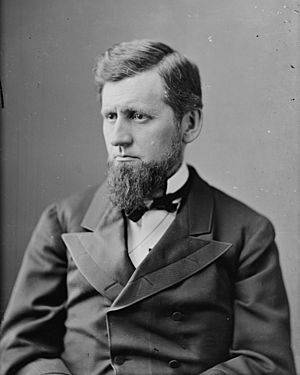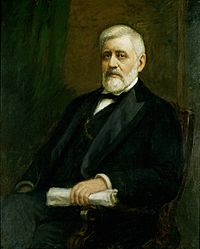William B. Allison facts for kids
Quick facts for kids
William B. Allison
|
|
|---|---|
 |
|
| Chairman of the Senate Republican Conference | |
| In office March 4, 1897 – August 4, 1908 |
|
| Preceded by | John Sherman |
| Succeeded by | Eugene Hale |
| United States Senator from Iowa |
|
| In office March 4, 1873 – August 4, 1908 |
|
| Preceded by | James Harlan |
| Succeeded by | Albert B. Cummins |
| Member of the U.S. House of Representatives from Iowa's 3rd district |
|
| In office March 4, 1863 – March 3, 1871 |
|
| Preceded by | District created |
| Succeeded by | William G. Donnan |
| Personal details | |
| Born |
William Boyd Allison
March 2, 1829 Perry, Ohio, U.S. |
| Died | August 4, 1908 (aged 79) Dubuque, Iowa, U.S. |
| Political party | Republican |
| Spouses | Anna Carter Allison Mary Neally Allison |
| Education | Allegheny College Western Reserve College |
| Profession | Politician, Lawyer |
| Signature | |
| Military service | |
| Allegiance | |
| Branch/service | |
| Rank | |
| Battles/wars | American Civil War |
William Boyd Allison (born March 2, 1829 – died August 4, 1908) was an important American politician. He was a key leader in the early Republican Party in Iowa. He served in the United States House of Representatives and later became a long-serving Senator for Iowa.
By the 1890s, Allison was known as one of the "big four" Republicans who had a lot of power in the Senate. He worked alongside other influential senators like Orville H. Platt, John Coit Spooner, and Nelson W. Aldrich.
Allison was born in Perry, Ohio. He became a lawyer in Dubuque, Iowa and quickly joined the new Republican Party. He helped choose Abraham Lincoln as a presidential candidate in 1860. In 1862, he was elected to the House of Representatives. After serving four terms there, he became a Senator in 1872.
He became the chairman of the powerful Senate Appropriations Committee. This committee decides how the government spends money. He led this committee for most years between 1881 and 1908. Four different presidents asked Allison to join their Cabinet, which are top advisors, but he always said no. Many people even wanted him to run for president in 1888 and 1896.
Allison was known as a calm and practical leader in the Senate. He helped pass several important laws. For example, the Bland–Allison Act of 1878 brought back a system where both gold and silver were used for money. He also helped pass important laws about tariffs, which are taxes on imported goods. These included the McKinley Tariff and the Dingley Act. He also helped pass the Hepburn Act, which gave courts power to review railroad shipping prices.
In 1908, Allison ran for a seventh term as Senator, which would have been a record. He won his party's primary election but sadly died soon after.
Contents
Early Life and Education
William Boyd Allison was born in Perry, Ohio. He went to Wooster Academy and then studied at Allegheny College in Pennsylvania. In 1849, he graduated from Western Reserve College.
After college, he studied law and became a lawyer in Ashland, Ohio. He worked there from 1852 to 1857. During this time, he was part of the 1855 Ohio Republican Convention. In 1857, he moved to Dubuque, Iowa, which became his home for the rest of his life.
Civil War Role
When Allison moved to Dubuque, he quickly became important in the new Republican Party. He was a delegate at the 1860 Republican National Convention in Chicago. At this meeting, Abraham Lincoln was chosen to run for President of the United States.
During the American Civil War, Allison worked for Iowa Governor Samuel J. Kirkwood. The governor asked him to help raise groups of soldiers, called regiments, for the war. Allison personally helped create four regiments. He was given the rank of lieutenant colonel, but he likely did not fight in battles.
In 1862, while the war was still happening, Allison was elected to the United States House of Representatives. He represented Iowa's new 3rd congressional district. As a congressman, he was on the House Ways and Means Committee. He supported higher tariffs, which are taxes on goods coming into the country.
Political Career After the War

After the Civil War, Allison continued to serve in the House. He won re-election in 1866 and 1868. In 1870, he tried to become a U.S. Senator but lost.
Instead of running for his House seat again, he focused on becoming a Senator in 1872. He worked hard to gain support from state lawmakers. In January 1872, he won enough votes to become a U.S. Senator for Iowa. He officially started his term on March 4, 1873.
Allison was re-elected to the Senate six more times. This meant he served for many years, winning elections in 1878, 1884, 1890, 1896, and 1902.
As Allison gained more experience, he got a very powerful position. From 1881 to 1893, and again from 1895 until his death in 1908, he was the chairman of the Senate Appropriations Committee. This committee is very important because it controls how the government spends money. Allison served as chairman for more years than anyone else. He was also a member of other important committees, including the Senate Committee on Indian Affairs and the Senate Finance Committee. In 1897, he became the chairman of the Senate Republican Conference, which is a leadership role for Republicans in the Senate.
Three different presidents asked Allison to become the Secretary of the Treasury, a top financial job. He accepted once but then changed his mind. He also declined an offer from President William McKinley to be the U.S. Secretary of State in 1897.
Allison was known for being a wise and practical leader. He was trusted by many different groups, even Democrats. He played a big part in creating important laws about tariffs, like the 1890 McKinley Tariff and the 1897 Dingley Tariff.
He also helped change the Bland bill, which wanted to allow a lot of silver money to be made. Allison changed it so the government would buy a smaller, limited amount of silver. This became the Bland–Allison Act of 1878. This law passed even though President Rutherford B. Hayes did not approve of it. Allison also helped create the Gold Standard Act in 1900, which made gold the main basis for U.S. money.
In 1896, some people thought Allison might become president, but the support for him faded.
People admired Allison for his experience and wisdom. He was known as "the Old Fox" because he was so clever and good at finding compromises. He didn't give long speeches but spoke briefly and quietly when he had something important to say.
Allison was married twice. His first wife, Anna Carter, died in 1859. His second wife, Mary Neally, died in 1883.
1908 Senate Election
United States Senate election in Iowa, 1908 In 1908, Allison was almost 80 years old and had served in Congress for 44 years. He decided to run for a record seventh term in the Senate. However, Iowa's Republican Governor, Albert B. Cummins, also wanted to be a U.S. Senator. Cummins was a leader of the "progressive" Republicans, who wanted to change things.
Even though Cummins seemed to promise he wouldn't challenge Allison, he ran against him in the Republican primary election on June 2, 1908. This was Iowa's first-ever primary election for Congress. The election was very competitive. Allison won against Cummins by more than ten thousand votes. A local newspaper even celebrated his win with the headline "GLORY TO GOD!"
Death and His Legacy
Allison did not live to see the general election or start his seventh term. Two months after winning the primary, he died in Dubuque. Many people were surprised, but news reports later said he had been sick for over two years. He was buried in Linwood Cemetery in Dubuque.
Governor Cummins was later chosen to fill Allison's Senate seat. He also won the next full term.
Allison, Iowa, a town in Butler County, was named after Senator Allison.
The Allison-Henderson Park in Dubuque is named in honor of Allison and another important person from Dubuque, U.S. Speaker of the House David B. Henderson.
There is also a large monument to Allison at the Iowa State Capitol in Des Moines. It was created by the sculptor Evelyn Beatrice Longman.
Images for kids


